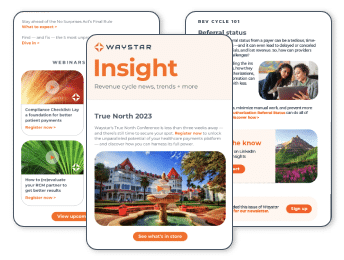A growing self-pay population and more high-deductible plans means providers need to focus more than ever on improving collections. Core to that focus is the need to better understand a patient’s financial responsibility, which in turn allows them to make crucial decisions about how they structure payments, manage claims, and forecast revenue growth.
With an effective propensity to pay solution, providers can better assess when and what a patient can fairly be expected to pay. In turn, they can better allocate resources and direct billing teams, preparing them to more ably guide patients to fully paying off bills.
Below, we’ll explore three tips for providers considering implementing a propensity-to-pay solution. With our help, you’ll be able to select a solution that streamlines and improves collections while opening up resources vital for growing operations.
1. Consider the strategic potential of P2P
The most important aspect of your P2P solution is the strategic impact it can have. In other words, you need to consider how you can leverage your solution to strengthen workflows, support more strategic billing, increase patient engagement, and enhance reporting that builds data-driven process improvements.
Propensity to pay scoring systems categorize patients based on huge sets of data sources, including patient payment history. Drawing on both propriety and public records, these solutions forecast the probability of how, when and how much a person can be expected to pay.
Data-driven insights into areas such as your collection rate or percentage of balance paid to let you pinpoint adjustments to help staff match routines and reduce wasted effort — just one way P2P can have a greater effect on your operations.
Beyond tools that calculate a P2P score, you need a simple way to design your outreach and strategy based on the scores you collect. The analytics a P2P solution gives you access to can easily stratify accounts based on risk and value. With this information, you can decide which accounts will require fewer resources and can be kept in-house, and which are projected to require more resources and should be outsourced.
Be sure you’re partnering with an organization that can assess your current strategy and deliver workflows customized to your goals and available resources. After all, an effective propensity to pay solution needs to do more than give you numbers — it needs to enhance collection strategies and support a more effective way for patients to resolve bills.
2. Understand the power of tailored communication strategies
Knowing upfront how a patient is expected to pay lets your team better manage those in-house accounts. With a more comprehensive understanding of payment patterns, you can both optimize and personalize patient communications.
Software can automatically configure the frequency, volume, and channels of outreach most likely to be effective with patients based on their past behavior. That information will illustrate the most effective path to guide patients to completely paying their bills. For example, you might use automated messages and emails as a low-cost effort to engage a reluctant patient, or simply send statements supplemented with targeted dialing for a patient who’s been identified as more likely to self-resolve their bill.
This is a way to improve collections as well as provide a more helpful, less frustrating patient experience. You may not need to repeatedly reach out to patients likely to pay on their own but can appropriately remind those who might have missed communications or otherwise forgotten to pay. Additionally, knowledge of a patient’s financial situation can help you include the right information and strike the right tone in your communications
3. Consider the source
Finally, it’s important to consider what specific data powers your vendor’s analytics. Some source data can activate a soft credit check. Research has shown, though, that people respond to Healthcare debt very differently than standard consumer debt. It’s also a practice that’s begun to attract criticism that it can negatively affect patient trust. Consider too that others operate with data sourced from outside the healthcare industry, which will further dull a solution’s accuracy.
Look into your vendor’s background and ask about how they source their data. It’s important for them to qualify and quantify that information — especially because that info is core to the efficacy of your solution.
The wrap up
Implementing an effective propensity-to-pay solution will help improve not just collections, but the overall patient experience. How successful it will depend not just on its ability to produce accurate scores, but on how much you can do with that information.
Measuring ongoing performance, analyzing trends, and re-evaluating your strategy for maximum returns is perhaps the most important factor for the long-term success of your strategy. That’s why it’s important to choose a partner with extensive experience in the implementation and analysis of self-pay receivables based on P2P.
If you’re looking for further guidance, Waystar offers Advanced Propensity to Pay as part of a suite of solutions that enhance the patient financial experience. Intuitive and easy to implement, our platform can help you improve collections and equip your team to start building the customized experience your patients are looking for.


